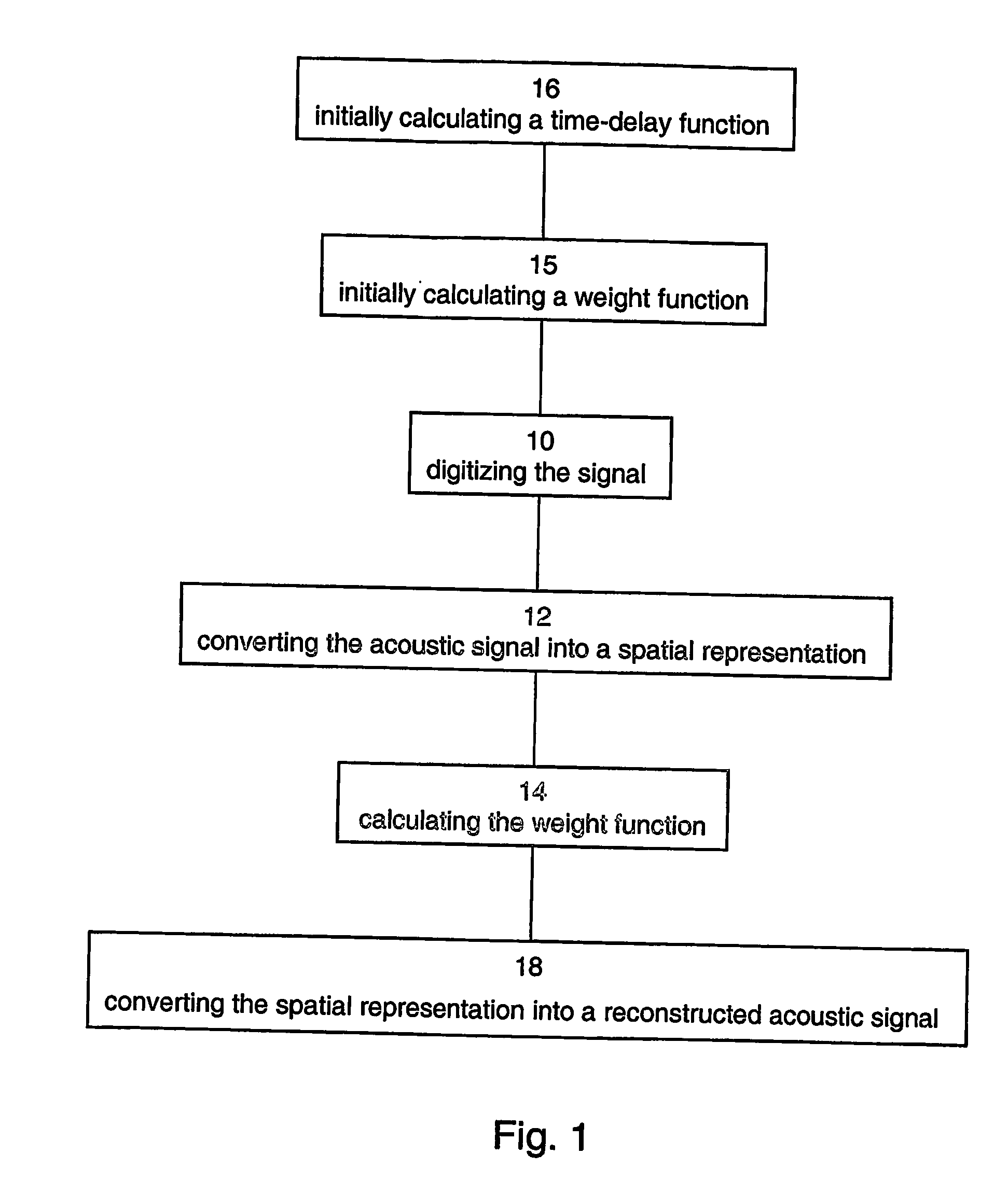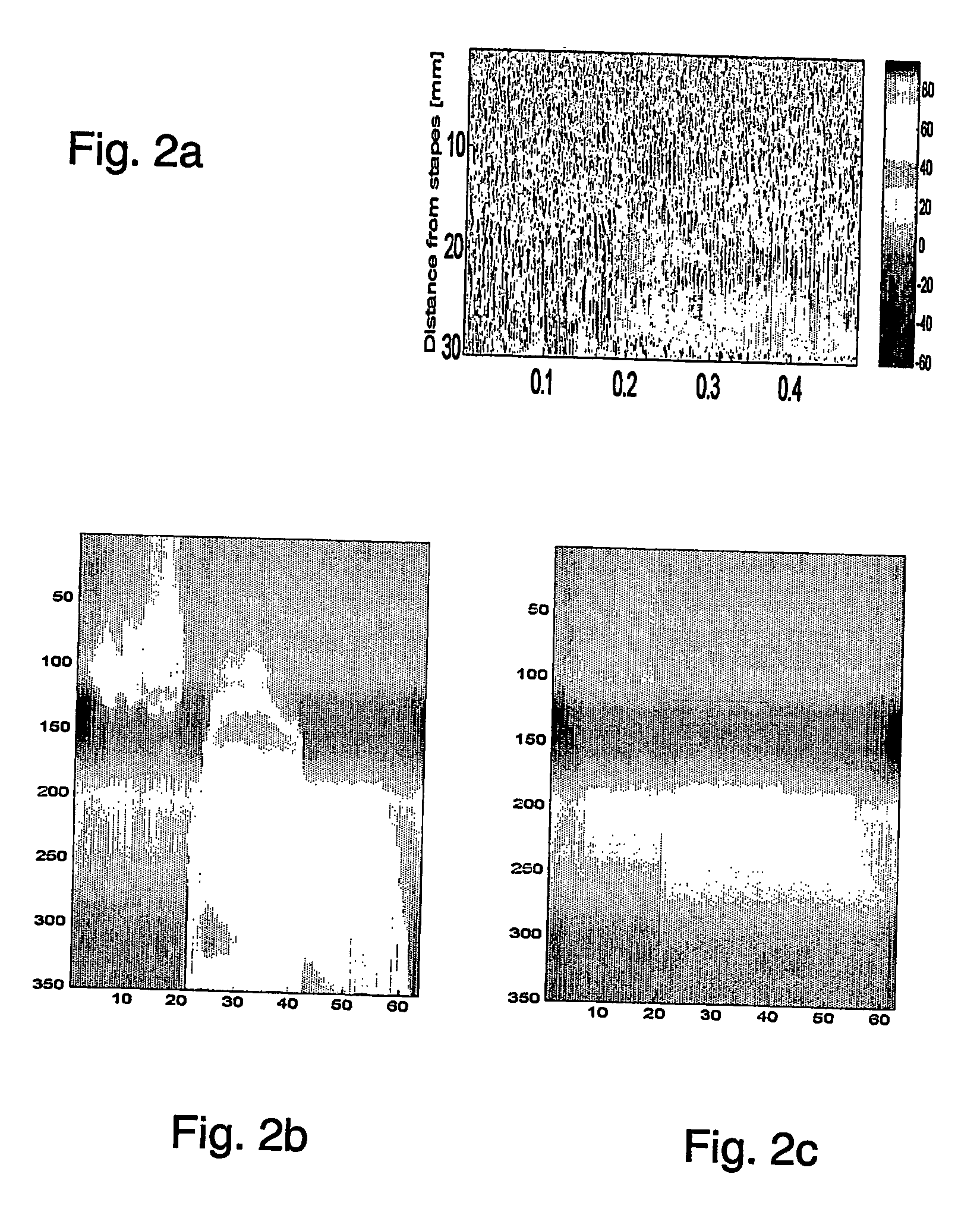Method apparatus and system for processing acoustic signals
a technology of acoustic signals and processing methods, applied in the field of digital processing of acoustic signals, can solve the problems of discomfort for users, difficulty in adjusting the sound perception of hearing aids of this type, complex operation of hearing aids, etc., and achieve the effect of improving the signal-to-noise ratio of acoustic signals
- Summary
- Abstract
- Description
- Claims
- Application Information
AI Technical Summary
Benefits of technology
Problems solved by technology
Method used
Image
Examples
example 1
Derivation of the Anatomical Model
[0157] In the present example, an outer hair cell model is combined with a complete time-domain one-dimensional cochlear model. The two models control each other through the motion of the basilar membrane.
[0158] Mechanical Contribution
[0159] In a simple one-dimensional model of the cochlea the cochlea is considered as an uncoiled two fluid-filled rigid-walled compartments separated by a basilar membrane [see, e.g., Zwislocki J. J., “Theory of the acoustical action of the cochlea,” 1950, J. Acoust. Soc. Am. 22, 778-784; Zweig, G., Lipes, R. and Pirce J. R, “The cochlear compromise,” 1976, J. Acoust. Soc. Am, 59, 975-982; Viergever, M. A. “Mechanics of the inner ear a mathematical approach,” 1980, Delft University of technology, Netherlands; and Furst, M., Goldstein, J. L, “A cochlear transmission line model compatible with psychophysics,” . 1982, J. Acoust. Soc. Am., 72:717-726].
[0160] The basic equations governing the motion of the basilar membr...
example 2
Solution of the Anatomical Model
[0184] Frequency Domain Solution
[0185] The simplified electrical contribution (Equations 4, 19 and 21 hereinabove) of the anatomical model is particularly effective in low stimuli level, were the second order Boltzmann functions can be approximated by linear functions for the capacitance, conductance, length change and stiffness.
[0186] In this example, the following linear approximation is assumed: GAP=αG0+αG·ξBMCAP=αC0+αC·ξBMΔ lOHC=α10-α1·ψ},(EQ. 22)
where, αG, αC, and α1 are all positive numbers. Substituting the Equations 22 in Equation 19 one finds the following differential equation for POHC: ∂POHC∂t+ωOHC·POHC=γ·[α1·ξBM+α2·∂ξBM∂t+α0],(EQ. 23)
where α0, α1 and α2 are derived from the Equations 19, 4, and 22, which yields that α0=0. The density parameter γ is preferably selected in the interval [0, 1]. One of ordinary skill in the art would appreciate upon inspecting Equation 23 that POHC increases with γ.
[0187] In order to obtain the val...
example 3
Psychophysical Tests
[0235] The purpose of the experiment of the present example is to evaluate the benefit of the reconstructed signals to different subjects' population. The experiment consists of “word identification” in an open-set.
[0236] Subjects
[0237] Four groups of subjects with at least 10 subjects in each group were tested:
[0238] (i) Normal hearing (control group), which consisted volunteers that match in age the other tested groups.
[0239] (ii) Traumatic impaired hearing, consisted of subjects following trauma such as soldiers, blast injuries, which usually suffer from inability to suppress noise, and their audiogram show a significant increase in threshold at 4 kHz. Their hearing loss is frequently defined as sub-clinical, and therefore they do not wear hearing aids.
[0240] (iii) Impaired hearing using conventional analog or digital hearing aids. These subjects (with hearing loss of up to 60 dB) enjoy amplification, filtration, and amplitude limitation (compression) ca...
PUM
 Login to View More
Login to View More Abstract
Description
Claims
Application Information
 Login to View More
Login to View More - R&D
- Intellectual Property
- Life Sciences
- Materials
- Tech Scout
- Unparalleled Data Quality
- Higher Quality Content
- 60% Fewer Hallucinations
Browse by: Latest US Patents, China's latest patents, Technical Efficacy Thesaurus, Application Domain, Technology Topic, Popular Technical Reports.
© 2025 PatSnap. All rights reserved.Legal|Privacy policy|Modern Slavery Act Transparency Statement|Sitemap|About US| Contact US: help@patsnap.com



